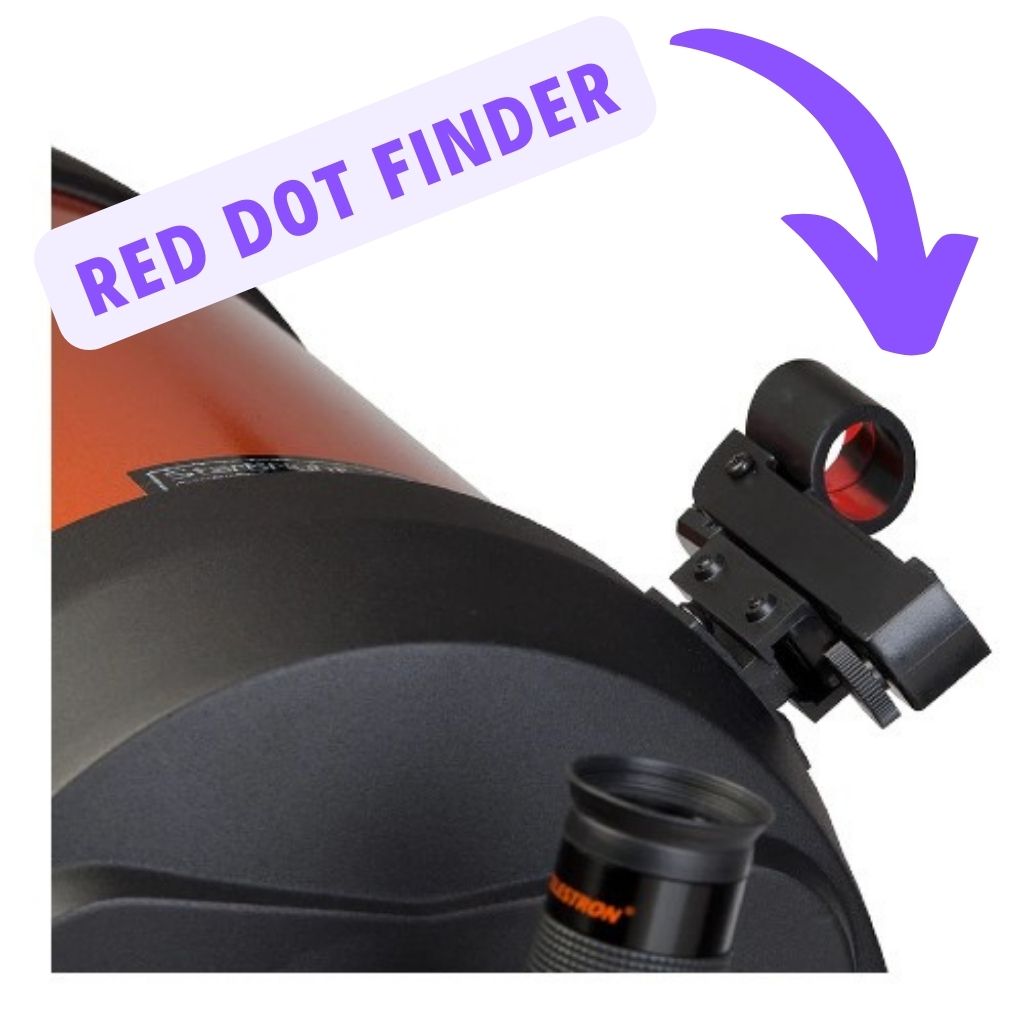This site contains affiliate links to products. I may receive a commission for purchases made through these links.
A red dot finder is an optical device used in astronomy to assist in locating and aligning telescopes with celestial objects. The red dot serves as a visual reference point, helping users point their telescopes toward desired objects in the sky.
Red dot finders are known for their simplicity, wide field of view, and ease of use.
If you’ve recently delved into the exciting world of astronomy or are considering getting your first telescope, you may have come across the term “red dot finder.”
While it might sound like something out of a military movie, a red dot finder is actually a handy tool that can greatly enhance your stargazing experience.
In this article, we will break down the functionality and mechanics of a red dot finder, demystifying its purpose and providing you with the knowledge you need to make the most of this essential accessory.
How a red dot finder works
A red dot finder is a popular tool used by astronomers and stargazers to assist in locating celestial objects in the night sky.
Despite its compact size and simplicity, a red dot finder can be incredibly helpful, especially for beginners who are still getting familiar with the night sky.
The functioning of a red dot finder is relatively straightforward. It consists of a small window or lens at the back, through which you look, and a red dot projected onto a clear glass screen or lens at the front.
The key principle behind its operation lies in the concept of non-magnifying reflex sights commonly used in shooting sports and military applications.
When you peer through the small window of a red dot finder, you’ll notice a red dot superimposed on the night sky. This dot appears to hover over the stars or objects you’re viewing.
Unlike traditional telescopic sights, the red dot finder doesn’t magnify the view; instead, it provides a simple aiming mechanism.
The red dot itself is created by a light-emitting diode (LED) located within the red dot finder. This LED emits a small, focused beam of red light onto the clear glass screen or lens, resulting in a visible red dot.
The dot remains fixed in place, regardless of the telescope’s movement, making it an ideal reference point for targeting celestial objects.
Red dot finders are often equipped with adjustable knobs or screws that allow you to align the dot with your telescope’s field of view.
How to align a red dot finder?
Aligning a red dot finder is crucial to ensure accurate pointing and tracking of celestial objects.
Here’s a step-by-step guide on how to align a red dot finder with your telescope:
Mount your red dot finder
Begin by securely mounting the red dot finder onto your telescope. Most finders come with mounting brackets that can be attached to the telescope’s optical tube or accessory shoe.
Make sure to position the red dot finder on the sky right side of your telescope tube to facilitate seamless navigation and alignment with celestial objects.
Align your telescope tube with the up down motion of the red dot finder, ensuring the left to right correct motion is for precise targeting of celestial objects in the night sky.
Choose a bright, easily identifiable object
Select a bright and easily recognizable celestial object in the night sky. This can be a prominent star, the Moon, or a planet. Ensure that the object is within the field of view of your telescope.
Keep the bright star within the red dot as you make left right motion, allowing you to track the same object smoothly and accurately.
Center the object in your telescope’s eyepiece
Look through the telescope’s eyepiece and manually adjust its position until the chosen object is centered within the field of view. Take your time to precisely position the object as accurately as possible.
Adjust the red dot finder’s alignment knobs
While keeping your eye on the telescope’s eyepiece, use the alignment knobs on the red dot finder to move the red dot until it aligns with the centered object in the eyepiece.
The knobs typically allow you to adjust the dot’s position vertically and horizontally.
Confirm alignment
Once you have made adjustments to align the red dot with the celestial object, take a moment to verify the alignment. Look back through the telescope’s eyepiece and ensure that the red dot remains fixed over the object without any noticeable drift.
Fine-tune if necessary
If the red dot is slightly off, make minor adjustments using the alignment knobs until it accurately overlaps with the centered object.
Remember to take your time and make precise movements to achieve the desired alignment.
Test the alignment
To confirm the accuracy of the alignment, choose another celestial object and repeat the process of centering it in the telescope’s eyepiece. Verify that the red dot accurately corresponds to the new object’s position.
Repeat the alignment process periodically
Over time, vibrations and movement may cause the red dot finder to lose its alignment. It’s a good practice to periodically check and readjust the alignment to ensure optimal performance.
Advantages of red dot finders
Red dot finders offer several advantages. Let’s explore some of the key advantages of using a red dot finder:
Easy to use
Red dot finders are designed to be user-friendly, making them ideal for beginners. They provide a simple and intuitive aiming mechanism, allowing users to quickly and easily align their telescopes with celestial objects.
Quick object acquisition
Traditional finderscopes often require manual scanning and searching for objects in the sky, which can be time-consuming and challenging, especially for newcomers.
Red dot finders streamline this process by providing a clear red dot reference point that helps users quickly locate and center objects in their telescope’s field of view.
Non-magnifying
Unlike finderscopes with magnifying optics, red dot finders do not magnify the view. This can be advantageous when locating faint or small objects in the sky.
The non-magnifying nature of red dot finders allows for a wider field of view, making it easier to identify and track objects.
Lightweight and compact
Red dot finders are typically lightweight and compact, adding minimal bulk and weight to your telescope setup. This makes them convenient for travel and field observations, as they are easy to carry and do not add significant strain to your equipment.
Minimal impact on balance
Red dot finders are often mounted in a way that minimally affects the telescope’s balance. This is particularly advantageous for telescopes with delicate or precise balance requirements, ensuring that the system’s overall stability is maintained.
Versatility
Red dot finders can be used with a wide range of telescopes, including refractors, reflectors, and catadioptric designs. They are compatible with various mounting systems and can be easily adjusted to suit different telescopes and user preferences.
Limitations of red dot finders
While red dot finders have their advantages, it’s important to consider their limitations as well.
Here are some key limitations of red dot finders:
Limited precision
Red dot finders provide a general aiming reference but lack the precision offered by more advanced finderscopes or computerized systems.
The size of the red dot itself can sometimes cover a significant area of the sky, making it challenging to precisely pinpoint small or faint objects.
Lack of magnification
Unlike traditional finderscopes with magnifying optics, red dot finders do not offer magnification. This can make it difficult to locate very dim or distant objects that require a higher level of detail.
Dependence on ambient lighting
Red dot finders work by projecting a red dot onto a clear glass screen or lens.
However, in bright or light-polluted environments, the red dot can become less visible or overpowered by surrounding light. This can make using the red dot finder more challenging in certain conditions.
Limited usefulness in daylight
Red dot finders are primarily designed for nighttime celestial observations. In daylight or under bright sunlight, the red dot may be washed out and difficult to see, reducing their effectiveness for daytime use or observing objects like the Sun.
Limited range
Red dot finders are best suited for objects visible to the naked eye or larger celestial objects like planets and bright stars.
They may not be as effective for locating very dim or small objects, such as distant galaxies or faint nebulae.
Single-point reference
Red dot finders typically offer a single red dot as a reference point. While this is sufficient for most observations, it may not provide the same level of detail or precision as finderscopes with multiple reticles or crosshairs.
You may also like: How To Collimate Mirrors On Newtonian Reflector
Red dot finder maintenance and care
Proper maintenance and care of your red dot finder can help ensure its longevity and optimal performance.
Here are some important guidelines to follow:
Keep it clean
Regularly clean the lens or clear glass screen of your red dot finder to remove dust, dirt, or smudges that may affect visibility.
Use a soft, lint-free cloth or lens-cleaning solution specifically designed for optical surfaces.
Avoid using harsh chemicals or abrasive materials that could scratch or damage the lens.
Protect from moisture and extreme temperatures
Avoid exposing your red dot finder to excessive moisture or extreme temperatures. Moisture can damage the internal components, while extreme heat or cold may affect the performance and alignment.
Store the finder in a dry, temperature-controlled environment when not in use.
Check battery life
If your red dot finder uses batteries, regularly check the battery life and replace them as needed.
Weak batteries can result in dim or intermittent red dot projection, impacting your ability to locate objects accurately.
Store properly
Store your red dot finder in a protective case or pouch to shield it from dust, scratches, or accidental damage when not in use. Proper storage helps maintain its condition and prevents any unnecessary wear and tear.
Follow the manufacturer’s guidelines
Always refer to the manufacturer’s instructions and guidelines for specific maintenance recommendations and care instructions tailored to your red dot finder model.
They may provide additional insights on cleaning, battery replacement, or other maintenance procedures.
What is the best red dot finder?
Determining the best red dot finder depends on individual preferences and specific requirements.
However, several reputable brands are known for producing high-quality red dot finders.
One of them is Telrad Finder. The Telrad Finder Sight Red/Green Switchable is a versatile tool for telescope pointing, offering selectable red or green illumination. It provides accurate sky alignment and is also used in stage lighting.
The SVBONY Red Dot Finderscope is another great option. It is designed for Celestron 80EQ, 80DX, 90DX, SE, and SLT astronomical telescopes. With its slide-in bracket, it can be easily installed on the telescopes.
More options here: 17 Best Red Dot Finders for Telescope (Ranked!)
FAQs
Here are some frequently asked questions about red dot finders:
Do red dot finders need batteries?
Most red dot finders require batteries to power the light-emitting diode (LED) that projects the red dot. The specific type of battery required can vary depending on the model of the red dot finder.
What is the difference between optical finders and red dot finders?
The main difference between an optical finder and a red dot finder is the design and functionality.
Optical finders, such as a traditional finderscope, use magnifying optics and crosshairs or reticles to help align the telescope with celestial objects.
They provide a magnified view of the sky, allowing for more precise targeting. They also offer a clear view of your target through a low power eyepiece.
On the other hand, red dot finders do not offer magnification. Instead, they project a non-magnified red dot onto a clear glass screen or lens, acting as a reference point for object alignment.
Red dot finders provide a wider field of view and a simpler aiming mechanism, making them easier to use for quick object acquisition.
Is a red dot finder the same as a laser?
A red dot finder is not the same as a laser. While both devices can be used for object pointing and alignment, they operate differently.
A red dot finder uses a light-emitting diode (LED) to project a red dot onto a screen or lens, providing a visual reference for object targeting. The red dot is not a concentrated beam of light but a diffuse dot.
In contrast, a laser pointer emits a focused, concentrated beam of light that can be seen as a distinct line or dot in the sky.
Laser pointers are not commonly used as finders in astronomy because they can cause accidental eye damage or interference with other observers.
Using lasers responsibly and adhering to safety guidelines when using them for any purpose is important.
Finderscope vs red dot finder, which is better?
Both a red dot finder and a finder scope have their own advantages and serve different purposes in astronomy.
Red dot finders are great for quickly locating the general area of the sky you want to observe, thanks to their wide field of view and ease of use.
For a comfortable viewing experience, a right angle finder enables you to observe objects at different angles while the red dot appears for accurate alignment.
Once you have the general area, a finderscope, with its magnification and precise targeting, can help you fine-tune and center the celestial object within the field of view of your telescope.
The convenience of multiple mounting bracket holes ensures easy installation and compatibility with various telescope models when using a finder scope.
Takeaway: Elevate your stargazing experience with red dot finders, the ultimate accessories for effortless celestial navigation
A red dot finder is a valuable tool for both beginners and experienced astronomers, offering a user-friendly and efficient way to locate celestial objects in the night sky. The adjustable red dot allows for precise alignment with celestial objects.
Its advantages include ease of use, quick object acquisition, non-magnifying wide field of view, and compatibility with various telescope designs.
While red dot finders have their limitations, such as limited precision and dependence on ambient lighting, they remain relevant due to their simplicity, portability, and compatibility with different telescopes.
Proper maintenance and care of your red dot finder, including regular cleaning and protection from moisture and extreme temperatures, will help ensure its longevity and optimal performance.
You may also like:







